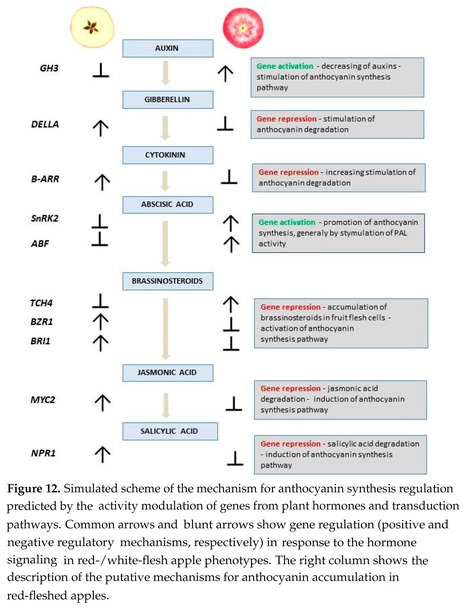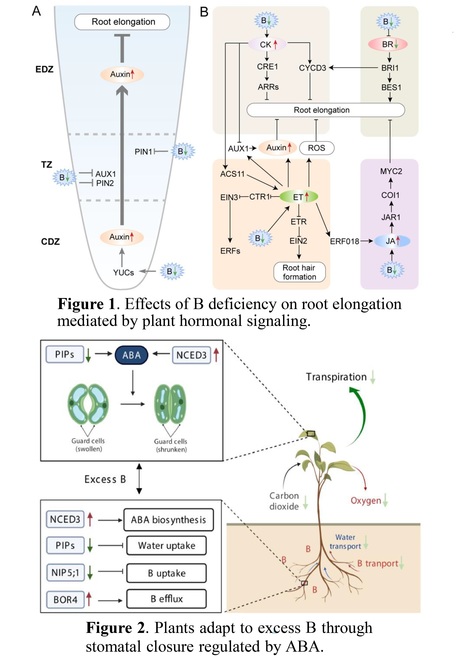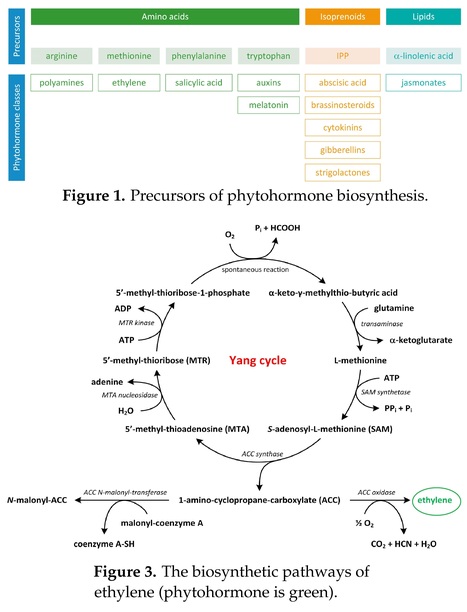 Your new post is loading...
 Your new post is loading...
Authors: Sylwia Keller-Przybylkowicz, Michal Oskiera , Xueqing Liu, Laiqing Song, Lingling Zhao, Xiaoyun Du, Dorota Kruczynska, Agnieszka Walencik, Norbert Kowara and Grzegorz Bartoszewski.
International Journal of Molecular Sciences (2024)
Abstract: "The red flesh coloration of apples is a result of a biochemical pathway involved in the biosynthesis of anthocyanins and anthocyanidins. Based on apple genome analysis, a high number of regulatory genes, mainly transcription factors such as MYB, which are components of regulatory complex MYB-bHLH-WD40, and several structural genes (PAL, 4CL, CHS, CHI, F3H, DFR, ANS, UFGT) involved in anthocyanin biosynthesis, have been identified. In this study, we investigated novel genes related to the red-flesh apple phenotype. These genes could be deemed molecular markers for the early selection of new apple cultivars. Based on a comparative transcriptome analysis of apples with different fruit-flesh coloration, we successfully identified and characterized ten potential genes from the plant hormone transduction pathway of auxin (GH3); cytokinins (B-ARR); gibberellins (DELLA); abscisic acid (SnRK2 and ABF); brassinosteroids (BRI1, BZR1 and TCH4); jasmonic acid (MYC2); and salicylic acid (NPR1). An analysis of expression profiles was performed in immature and ripe fruits of red-fleshed cultivars. We have uncovered genes mediating the regulation of abscisic acid, salicylic acid, cytokinin, and jasmonic acid signaling and described their role in anthocyanin biosynthesis, accumulation, and degradation. The presented results underline the relationship between genes from the hormone signal transduction pathway and UFGT genes, which are directly responsible for anthocyanin color transformation as well as anthocyanin accumulation during apple-fruit ripening."
Authors: Kaitlyn N. Greenwood, Courtney L. King, Isabella Melena, Katherine A. Stegemann, Maura Donnelly, Anna Childers, Raegan Mozal, Carina A. Collins and Benjamin J. Spears.
Plant Direct (2023)
Abstract: "Phloem is a critical tissue for transport of photosynthates and extracellular signals in vascular plants. However, it also represents an ideal environment for pathogens seeking access to valuable host nutrients. Although many vascular pathogens induce economically relevant crop damage, there is still little known about the mechanisms by which immune signaling operates through the phloem. An existing phosphoproteomic dataset was mined to identify proteins that were both phosphorylated in response to the defense-elicitor flagellin (flg22) and expressed in vascular cells. A single candidate, OCTOPUS (OPS), is polarly associated with the plasma membrane of sieve element cells and has been characterized as an inhibitor of brassinosteroid insensitive-2 in promotion of brassinosteroid-related phytohormone signaling. The observation that OPS is differentially phosphorylated in response to flg22 led us to the examine whether OPS may also regulate flg22-induced immune signaling. Two independent alleles of ops exhibited enhanced immunity outputs across multiple signaling branches of PAMP-triggered immunity (PTI), constitutively and in response to flg22 treatment. Together with our observation that interactions between OPS and brassinosteroid insensitive-2 were disrupted by induction of salicylic acid and depletion of brassinosteroid, these data support a model whereby OPS modulates brassinolide and immune signaling to control downstream responses. We present OPS as a novel addition to the list of proteins with documented roles in PAMP-PTI signaling. These results further indicate that immune signaling in the phloem may be a significant and unique component of the host detection and response to pathogens in vascular plants."
Authors: Xiaoshi Liu, Zian Chen, Liting Huang, Youwei Ouyang, Zhiying Wang, Shuang Wu, Weixian Ye, Boya Yu, Yihang Zhang, Chengwei Yang and Jianbin Lai.
The EMBO Journal (2023)
Synopsis: The subcellular localization and function of Arabidopsis BRASSINOSTEROID SIGNALING KINASEs (BSKs) is maintained by their S-acylation. This report describes how salicylic acid attenuates brassinosteroid signaling by inducing the expression of an enzyme which removes this tether. Most members of the Arabidopsis BSK family are S-acylated for their plasma membrane localization in plant cells. S-acylation is necessary for the function of BSKs but SA suppresses their function by decreasing their S-acylation. ABAPT11 is the enzyme that de-S-acylates BSKs, disrupting their plasma membrane localization. SA induces ABAPT11 expression, suppressing BR-mediated development via the de-S-acylation of BSKs.
Abstract: "Brassinosteroids (BRs) are important plant hormones involved in many aspects of development. Here, we show that BRASSINOSTEROID SIGNALING KINASEs (BSKs), key components of the BR pathway, are precisely controlled via de-S-acylation mediated by the defense hormone salicylic acid (SA). Most Arabidopsis BSK members are substrates of S-acylation, a reversible protein lipidation that is essential for their membrane localization and physiological function. We establish that SA interferes with the plasma membrane localization and function of BSKs by decreasing their S-acylation levels, identifying ABAPT11 (ALPHA/BETA HYDROLASE DOMAIN-CONTAINING PROTEIN 17-LIKE ACYL PROTEIN THIOESTERASE 11) as an enzyme whose expression is quickly induced by SA. ABAPT11 de-S-acylates most BSK family members, thus integrating BR and SA signaling for the control of plant development. In summary, we show that BSK-mediated BR signaling is regulated by SA-induced protein de-S-acylation, which improves our understanding of the function of protein modifications in plant hormone cross talk."
Authors: Xi Chen, Steven M. Smith, Sergey Shabala and Min Yu.
Journal of Experimental Botany (2023)
Abstract: "Boron (B) is an essential element for plant growth. Many agricultural soils around the globe have either insufficient or excessive amounts of available B, with major implications for crop production. Understanding major limitations imposed by B nutritional disorders may allow breeding crops for improved B use efficiency as well as make them more resilient to excessive B, thus reducing yield penalties. It has become apparent that B-related physiological disorders are mediated in large part by their impact on plant hormonal production and signaling. The aim of this review is to summarize the current knowledge of the roles of hormones in plant responses to B and their impact on plant growth and development. The most significant effect of B deficiency is the inhibition of root elongation. B deficiency promotes the redistribution of auxin in the root elongation zone. Together with cytokinin signals and ethylene, this redistribution and modulation of auxin content triggers inhibition of the root cell elongation. Under B deficiency, root development is also regulated by brassinosteroids and jasmonic acid. Excess B can induce the production of reactive oxygen species (ROS). Abscisic acid and salicylic acid are both produced in response to B toxicity, and both can induce the antioxidant defense system to detoxify ROS. Another adaptation to B toxicity involves changes in the expression levels and activity of aquaporins in roots, thus reducing the uptake of water and delivery of B into the transpiration stream. In addition, abscisic acid mediates stomatal closure to further limit transpiration and the consequent accumulation of B in leaves."
Authors: Jing Jing Zhang and Hong Yang.
Science of the Total Environment (2021)
Highlights: • Plants can metabolize pesticides through degradative enzymes and sequestration. • There are diverse reactions by which pesticides are metabolized. • Some signal molecules are involved in pesticide metabolism and detoxification. • Epigenetic mechanism is involved in metabolism of pesticides in plants.
Abstract: "Pesticides make indispensable contributions to agricultural productivity. However, the residues after their excessive use may be harmful to crop production, food safety and human health. Although the ability of plants (especially crops) to accumulate and metabolize pesticides has been intensively investigated, data describing the chemical and metabolic processes in plants are limited. Understanding how pesticides are metabolized is a key step toward developing cleaner crops with minimal pesticides in crops, creating new green pesticides (or safeners), and building up the engineered plants for environmental remediation. In this review, we describe the recently discovered mechanistic insights into pesticide metabolic pathways, and development of improved plant genotypes that break down pesticides more effectively. We highlight the identification of biological features and functions of major pesticide–metabolized enzymes such as laccases, glycosyltransferases, methyltransferases and ATP binding cassette (ABC) transporters, and discuss their chemical reactions involved in diverse pathways including the formation of pesticide S–conjugates. The recent findings for some signal molecules (phytohomormes) like salicylic acid, jasmonic acid and brassinosteroids involved in metabolism and detoxification of pesticides are summarized. In particular, the emerging research on the epigenetic mechanisms such DNA methylation and histone modification for pesticide metabolism is emphasized. The review would broaden our understanding of the regulatory networks of the pesticide metabolic pathways in higher plants."
|
Authors: Chuankai Zhao, Diego E. Kleiman and Diwakar Shukla.
Journal of Biological Chemistry (2023)
Abstract: "Plant hormones are small molecules that regulate plant growth, development, and responses to biotic and abiotic stresses. They are specifically recognized by the binding site of their receptors. In this work, we resolved the binding pathways for eight classes of phytohormones (auxin, jasmonate, gibberellin, strigolactone, brassinosteroid, cytokinin, salicylic acid, and abscisic acid) to their canonical receptors using extensive molecular dynamics simulations. Furthermore, we investigated the role of water displacement and reorganization at the binding site of the plant receptors through inhomogeneous solvation theory. Our findings predict that displacement of water molecules by phytohormones contributes to free energy of binding via entropy gain and is associated with significant free energy barriers for most systems analyzed. Also, our results indicate that displacement of unfavorable water molecules in the binding site can be exploited in rational agrochemical design. Overall, this study uncovers the mechanism of ligand binding and the role of water molecules in plant hormone perception, which creates new avenues for agrochemical design to target plant growth and development."
Authors: Andrzej Bajguz and Alicja Piotrowska-Niczyporuk.
Metabolites (2023)
Abstract: "Phytohormones exhibit a wide range of chemical structures, though they primarily originate from three key metabolic precursors: amino acids, isoprenoids, and lipids. Specific amino acids, such as tryptophan, methionine, phenylalanine, and arginine, contribute to the production of various phytohormones, including auxins, melatonin, ethylene, salicylic acid, and polyamines. Isoprenoids are the foundation of five phytohormone categories: cytokinins, brassinosteroids, gibberellins, abscisic acid, and strigolactones. Furthermore, lipids, i.e., α-linolenic acid, function as a precursor for jasmonic acid. The biosynthesis routes of these different plant hormones are intricately complex. Understanding of these processes can greatly enhance our knowledge of how these hormones regulate plant growth, development, and physiology. This review focuses on detailing the biosynthetic pathways of phytohormones."
Authors: Lingling Yin, Mark Zander, Shao-shan Carol Huang, Mingtang Xie, Liang Song, J. Paola Saldierna Guzmán, Elizabeth Hann, Bhuvana K. Shanbhag, Sophia Ng, Siddhartha Jain, Bart J. Janssen, Natalie M. Clark, Justin Walley, Travis Beddoe, Ziv Bar-Joseph,Mathew G. Lewsey and Joseph R. Ecker.
bioRxiv (2023)
Abstract: "Cross-regulation between hormone signaling pathways is indispensable for plant growth and development. However, the molecular mechanisms by which multiple hormones interact and co-ordinate activity need to be understood. Here, we generated a cross-regulation network explaining how hormone signals are integrated from multiple pathways in etiolated Arabidopsis (Arabidopsis thaliana) seedlings. To do so we comprehensively characterized transcription factor activity during plant hormone responses and reconstructed dynamic transcriptional regulatory models for six hormones; abscisic acid, brassinosteroid, ethylene, jasmonic acid, salicylic acid and strigolactone/karrikin. These models incorporated target data for hundreds of transcription factors and thousands of protein-protein interactions. Each hormone recruited different combinations of transcription factors, a subset of which were shared between hormones. Hub target genes existed within hormone transcriptional networks, exhibiting transcription factor activity themselves. In addition, a group of MITOGEN-ACTIVATED PROTEIN KINASES (MPKs) were identified as potential key points of cross-regulation between multiple hormones. Accordingly, the loss of function of one of these (MPK6) disrupted the global proteome, phosphoproteome and transcriptome during hormone responses. Lastly, we determined that all hormones drive substantial alternative splicing that has distinct effects on the transcriptome compared with differential gene expression, acting in early hormone responses. These results provide a comprehensive understanding of the common features of plant transcriptional regulatory pathways and how cross-regulation between hormones acts upon gene expression."
Authors: Qing Han, Wenrong Tan, Yuqing Zhao, Feng Yang, Xiuhong Yao, Honghui Lin and Dawei Zhang.
The EMBO Journal (2022)
Synopsis: How pathogen-induced salicylic acid (SA)-mediated expression of pathogenesis-related (PR) genes is integrated into more long-term signals is incompletely understood. Here, the brassinosteroid signaling kinase BIN2 is found involved in SA signaling via TGA transcription factor phosphorylation. BIN2 is an indispensable component of SA signaling; BIN2 interacts with and phosphorylates TGA3; SA-induced phosphorylation of TGA3 by BIN2 promotes the interaction between TGA3 and NPR1, which enhances the transcriptional activity of TGA3; SA-induced TGA3 phosphorylation positively regulates plant immunity.
Abstract: "The plant defense hormone, salicylic acid (SA), plays essential roles in immunity and systemic acquired resistance. Salicylic acid induced by the pathogen is perceived by the receptor nonexpressor of pathogenesis-related genes 1 (NPR1), which is recruited by TGA transcription factors to induce the expression of pathogenesis-related (PR) genes. However, the mechanism by which post-translational modifications affect TGA's transcriptional activity by salicylic acid signaling/pathogen infection is not well-established. Here, we report that the loss-of-function mutant of brassinosteroid insensitive2 (BIN2) and its homologs, bin2-3 bil1 bil2, causes impaired pathogen resistance and insensitivity to SA-induced PR gene expression, whereas the gain-of-function mutant, bin2-1, exhibited enhanced SA signaling and immunity against the pathogen. Our results demonstrate that salicylic acid activates BIN2 kinase, which in turn phosphorylates TGA3 at Ser33 to enhance TGA3 DNA binding ability and NPR1–TGA3 complex formation, leading to the activation of PR gene expression. These findings implicate BIN2 as a new component of salicylic acid signaling, functioning as a key node in balancing brassinosteroid-mediated plant growth and SA-induced immunity."
|



 Your new post is loading...
Your new post is loading...















